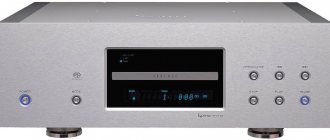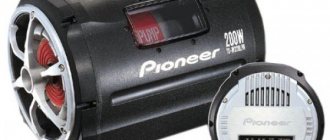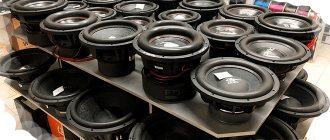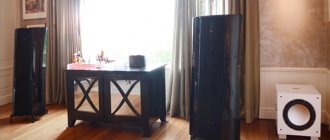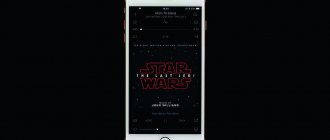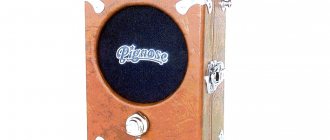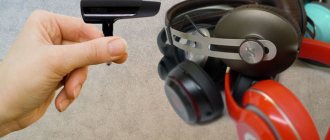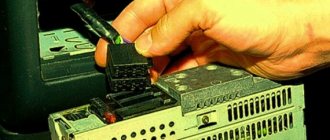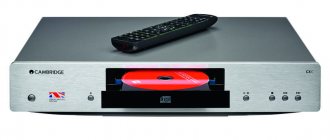Vinyl, of course, is a fashionable thing now, friends, but it will never have to overcome digital music distribution. For more than a decade and a half, digital audio sources have firmly held a dominant position in both the professional and consumer electronics sectors. Let's talk about how to squeeze the maximum Hi-Fi juice out of an assortment of fruits - from Internet radio stations to 24-bit audio.
Once upon a time, the CD player was the only solution, and was generally considered cool High End at first, but today this topic seems to be considered morally exhausted. Yes, in the old fashioned way, many still keep CDs in their collections, but as a physical medium it is inferior to vinyl, which simply looks more beautiful, and is technically inferior in terms of parameters to HD audio, which is already widely sold on the Internet not only by audiophiles, but also by major labels. So, instead of a CD player, we need a more versatile device with external inputs that could convert the binary code of zeros and ones into an analog signal that would then be fed to the amplifier and speakers eventually.
The best DAC for music. How to choose and how to understand?
In most cases, the DAC is built into the device you use to listen to music (TV, laptop, phone or tablet), but this version is not optimized for the best sound quality.
That's why if you want the best DAC, you need to purchase a separate device specifically designed for this purpose. You can use it with your laptop, TV, home theater system, phone and so on.
Even if there is a built-in version, this will be bypassed and the separate DAC will take over, creating a better sound. We've looked at some of the best products on the market and figured out how you can choose the best DAC for the money.
Characteristics
The DAC largely determines the parameters of the entire audio system and directly affects the quality of the resulting audio signal.
The main parameters of the quality level of recording in digital format are: sampling frequency (measured in Hz), bit depth (measured in bits) and bitrate (measured in kbit/s). These characteristics will be the main ones in choosing a DAC.
Music for the soul and “scratching” can only help
DAC modules are a little more complex than, say, choosing a pair of headphones, so we've put together these helpful recommendations that cover the key features to consider.
INPUTS AND OUTPUTS
If you look at DACs, you'll notice that most of them have multiple types of inputs (optical, coaxial, USB, and others). A good rule of thumb is to choose a device with multiple input types because that means you can use it with a wide range of devices, from mobile phones and tablets to TVs and even record players.
In terms of output, most of them support the classic 3.5mm output (for headphones), but modern devices also support BT connection.
Why do headphones sound bad?
In short: high-impedance headphones like high voltage, but they don't need high current. The battery of a smartphone or player most often simply cannot provide the built-in amplifier with sufficient voltage. Therefore, it is designed for headphones with low impedance, for which current is more important than voltage.
To answer in more detail, you need to make a couple of lyrical digressions. First you need to understand impedance .
Impedance is the nominal resistance at the headphone input, measured in Ohms. Based on the resistance value, all headphones can be divided into three groups:
- Low impedance - less than 40 ohms. Typically 16-32 ohms are most plugs and small headphones, many inexpensive over-ear models.
- Average - 60-100 Ohms. For example, Sennheiser HD 280 PRO. Well suited for recording drums: due to the 64 ohm impedance, they will produce significantly more volume than a 250 ohm model, but will not overload as easily as low-impedance headphones.
- High - more than 250 Ohms. Many studio and high-end models.
Why do headphones need high impedance at all? In fact, until recently, they didn’t bother much with the sound of “ears”. The highest quality sound was traditionally offered by studio models, and they were all high-impedance, because studio equipment always had powerful outputs. Low impedance headphones connected to them would sound too loud to the point of hurting the ears.
The second advantage, which we thought about a little later, is that higher voltage gives greater detail and better dynamics, the sound becomes more saturated, bright and deep. As a result, it became fashionable among hi-fi and high-end manufacturers to produce expensive high-impedance models, and today they occupy a significant part of the market. Of course, this does not mean that any high-impedance model sounds better than low-impedance headphones.
In addition to impedance, another important value is the sensitivity of the headphones. This is how many decibels they will produce per millivolt. There is a similar parameter - efficiency, measured in decibels per milliwatt, but sensitivity is usually indicated.
Now the rules:
- The higher the impedance the headphones have, the more voltage they need. Impedance determines how much power the amplifier can deliver to them.
- The lower the sensitivity of the headphones, the higher the current they require. The volume of the headphones depends on the sensitivity.
For example:
- Headphones Sony MDR-1AB. Their impedance is only 24 Ohms, and their sensitivity is 105 dB. The combination of low impedance and high sensitivity means that these headphones are much easier to power with electricity, even a regular smartphone can handle it.
- In contrast to them are the Shure SRH1840 headphones. It seems that with an impedance of 65 Ohms it would seem easy to drive them. But their sensitivity is only 96 dB, which means they need a lot of power - 1.5-4 W per channel for high volume!
- But the Sennheiser HD 650 have an impedance of as much as 300 Ohms, but with a relatively high sensitivity of 103 dB, it will be easier to select an amplifier for them.
However, even if the headphones are undemanding to the signal, this does not mean that the built-in amplifier of the smartphone or player does not spoil the quality of their sound. Often, cheap amplifiers introduce distortion, especially at high volumes, and also have annoying extraneous noise and background hum. They arise due to the influence of various radioelements on each other when the housing layout is too dense. External headphone amplifiers help overcome the limitations of built-in amplifiers.
Music is exactly that
In all respects, one of the best DACs in the world wins. Now we will introduce it to you.
CAMBRIDGE AUDIO DACMAGIC PLUS - Best Audiophile DAC
Cambridge Audio is one of the most renowned companies in the audio industry, producing a wide range of high quality products. So you can trust that the DacMagic Plus device will be ideal for most audiophiles and even professional musicians.
In fact, we think it's the best DAC under 500! The device features 24-bit Twin Wolfson DACs and uses AFT2 24-bit/384kHz upsampling with upsampling and jitter reduction. It also features BT wireless connectivity and selectable digital filters, giving the user customizable control.
The result is impeccable sound no matter the format or device you're using. You can use it with Blu-ray players, home theaters, phones, laptops and so on. When DacMagic Plus is connected to the network, you no longer need to worry about sound quality!
Pros:
- Twin Wolfson 24-bit DACs
- AFT2 Upsampling
- Asynchronous USB input
- It can also be used as a digital preamp
- BT connection
Minuses:
- A little expensive
- No remote control
- No volume indicator
It all depends on the source material
Of course, in order to get the best possible result from a DAC, you need to take care of the quality of the source material. Don't expect miracles when offering him MP3 files with a bitrate of 128 kbps. In fact, better decoding of the compressed signal can further highlight its shortcomings. For component DACs, CD-quality content or higher provides optimal results. Typically, music with this resolution is recorded in lossless PCM formats - FLAC, WAV or ALAC (Mac), as well as DSD.
The best Chinese DAC for music
The Chinese DAC will most likely differ little from the others, for only one reason: “they are all Chinese now.” =)
But nevertheless, there is one copy that is worth paying attention to. And this means exactly that even our Asian friends themselves prefer it!
CHORD ELECTRONICS MOJO DAC – Amp Combo
Even though it fits in the palm of your hand, this device is packed with features and functions. This is both a DAC and a headphone amplifier. This means you'll be able to make full use of the high-quality jars you just purchased!
This Mojo DAC was designed with portability in mind. Therefore, most users connect it to their phones, tablets or laptops and enjoy the result on their headphones. (in-ear headphones or studio headphones).
The good news is that it works with all operating systems on the market. Therefore, you will not have any problems with installation. Not to mention, it will remember the settings you last used.
Moreover, it plays almost any audio file as it supports 32-bit up to 768 kHz and four-channel DSD 256. The device is equipped with two 3.5mm analog ports. This means you can share music with another person. Finally, the LiPo battery provides eight to ten hours of playback, all within a solid aluminum frame.
Pros:
- Portable and easy to use.
- DAC and headphone amplifier in one device.
- Two 3.5 mm ports.
- Working hours are from 8 to 10 hours.
- Works with most devices and audio files.
- Solid aluminum frame.
Minuses:
- I can't carry it in my pocket.
- Doesn't work while charging.
- A little more expensive.
Choosing a hypothetical DAC - the main nuances. Part 1.
In modern society, among audiophiles and music lovers, not having a DAC is definitely bad manners.
And not because it is fashionable or hype, but because the DAC is essentially a new “carrier” of sound culture of the 21st century. Perhaps someone will argue that the new medium can rather be called streaming audio to network devices (in a previous life they were embodied in the form of stereo receivers playing FM radio), and I would agree, but so far the quality of network sound cannot be compared with -a truly audiophile “wired” system.
For what reason do you need a DAC?
1. A DAC is simply a convenient device that allows you, like a crocodile, to indiscriminately swallow virtually any files and, after digesting their contents, spew or spew them out in the form of music.
The advantage of a DAC over CD players is the following - at the moment, an average static inexpensive DAC, if chosen correctly, is capable of producing a sound that is more interesting and of higher quality than an average static inexpensive CD player.
The DAC has no moving parts, shafts, bezels, gears, lenses and other mechanics, the service life of which is limited. Those. if an old CD player can hypothetically cause you a number of problems - oh, main liben - with a dying “eye” - it reads this disc today, it doesn’t read this one, and this one is scratched, then the DAC is simply working.
Don't forget that DAC chips themselves have not stood still since the reign of CD players and often provide better performance and better sound. Of course, in the late 80s and now they make amazing-sounding players, but their price for the average music lover is very high, and it turns out that with a DAC it is easier and cheaper to get good sound.
Another advantage of the DAC is the enormous amount of music in the form of files. Of course, no fewer CDs were released earlier, but today try to find the right group and the store that sells it. Of course, it is faster and easier to get this album in the form of files.
Using a DAC, you will be surprised how much richer your choice of music has become without the limitations of physical media.
The next caveat is that when using an CD player you are “limited” only to the 44100 Hz and 16 bit format. This amazing quality is enough for me and I am not looking for more. But having a DAC, no one limits you in an essentially endless increase in quality. Do you want 96000 Hz and 24 bits? This is possible with a DAC. If you want 192,000 Hz, please. If you want 1,536,000 Hz, no problem, for example using the Denafrips ARES II DAC.
With a DAC you can listen to DSD, you can listen to PCM - all this luxury and power is at your disposal.
Of course, if you really want to become the owner of an CD player, then no one will forbid you, and this has its advantages, for example, a quick start to start listening, but in general, the CD can still limit you to one degree or another in choosing content according to compared to the DAC. Although 30 CDs on ebay will be enough for everyone in the next few years, there is no need to worry, but prices for really interesting musical things will most likely only rise, as is happening with vinyl - look, for example, at how much Rockets now costs on ebay or everyone’s favorite Pink Floyd.
To summarize, from some experience I can say that a cheap DAC usually sounds no worse, and sometimes even better, than a cheap CD player, but does not have mechanical problems (this does not negate the fact that the DAC can also burn out for some reason), supports more formats, and can play music (even very cheap ones) sometimes at the highest sampling values. Another point is that thanks to Chinese manufacturers, especially amateurs, today you can buy a decent new DAC really cheaply, cheaper than an entry-level CD player. Let's check this assumption.
The Denon dcd-520ae CD player offered on the shelves of modern Hi-Fi stores uses a rather old PCM1791 chip, released back in 2003.
With a price tag of 15,500 rubles, this would, in theory, be a good purchase, but Chinese developers are able to offer the best chips and solutions.
A DAC from aliexpress called SU2, or PCM1794 * 2 + AK4118 SU1 ADUM is offered at an average price of 9,000 rubles, but contains two more advanced PCM1794 chips, albeit from the same years (2003-2006), which use an excellent-sounding circuit and high-quality operational amplifiers LME49710/49720. In other words, at a significantly lower price, the SU2 DAC offers globally higher sound quality than the budget and more expensive Denon dcd-520ae CD player.
In principle, the much more expensive Marantz CD-6002 CD player on the CS4398 chip is not able to cope with SU2 and is inferior in detail, accuracy of spatial construction, and transparency.
Therefore, from my point of view, CD players (including SACD/Blu-Ray/DVD-Audio) are worth paying attention to if you choose a truly luxurious and extraordinary device (for example, the Pioneer DV-AX10, which was retailed at 500,000 yen - consider which is 5000 dollars), and not budget or mid-range solutions that will be inferior in functionality, capabilities, and, sadly, in most cases in sound, to modern DACs.
Why? Primarily for the reason that over the past time, with the development of digital audio, better operational amplifiers, both in terms of characteristics and sound, and discrete circuits have appeared, as well as the digital-to-analog converter chips themselves have reached incredible heights.
For example, if the PCM1791 chip in 2003-2006 could boast a dynamic range of 113 dB and THD+N of 0.001%, then the more advanced PCM1794 (of which, let me remind you, a pair is installed in the same SU2, which improves the performance) even alone produced 132 dB . True, in mono mode at 9 volts, which is why it is important that SU2 has 2 chips installed, which leads to such monstrously high values of 132 dB.
With a standard output of 2 volts, the DAC could boast an equally impressive value of 127 dB.
And at 4.5 volts - 129 dB.
I propose to digress a little from the topic and turn to people who often foam at the mouth to prove that XLR in pseudo-balanced circuits is of no use.
Take another look at the chip's output:
9 volts - 132 dB
4.5 volts - 129 dB
2 volts - 127 dB
Obviously, the dynamic range is higher, the higher the voltage range, and in XLR, even in a pseudo-balanced circuit, the voltage is still increased by 2 times, so the characteristics will be higher and this is audible, usually expressed in better three-dimensional space, more solid and tangible images .
In other words, higher voltage means higher resolution, but of course this is true in high-level Hi-Fi audio systems.
Also, many DAC chips, according to the datasheet, can show better performance at higher voltages, for example, the classic chip of the economical edition TDA1543.
Returning to the topic of DACs, I will also note that the PCM1794 is superior to the PCM1791 not only because of its greater dynamic range, but also because of significantly lower distortion - in the PCM1794 THD+N is an extremely low 0.0004%.
As for the Lme49710 and Lme49720 operational amplifiers used, they are extremely impressive in terms of parameters, but slightly limit the capabilities of the DAC, lowering it to their level, i.e. you can get even more impressive results.
The dynamic range of the Lme49710/49720 is limited to 120 dB, but the distortion is simply fantastically low - THD+N = 0.00003% (count the number of zeros at your leisure, instead of sheep before bed).
SU2 is presented in the review not as a standard, but as an extremely affordable and high-quality DAC. More expensive devices will be even better, providing richer sound in terms of nuances, sound texture, and microdynamics. The sound palette will certainly be enriched if you switch to a non-DAC based on more modern chips, for example Saber ES9018-9038PRO, provided that the analog part has an excellent circuit design.
The DAC device can be divided into several parts, each of which is important and affects the sound.
Below I will outline a small plan for the further story about the DAC design, which I will try to adhere to. This information will help you choose a DAC wisely, and just by looking at the hardware you will already have a rough idea of what level of device is in front of you. Of course, this does not guarantee that you will definitely fall in love with the sound of your new DAC, but it will help avoid a lot of disappointments that await you when choosing at random, or according to “advice”.
The DAC device consists of such blocks as
1. Power supply (linear, pulse, one or two transformers, stabilizer, etc.)
2. Transport receiving digital data (chips, USB, SPDIF, clock generators, femtoclocks, clock resonators).
3. NOS or OS (chips, reasons)
3. DAC chip (chip model, number of chips, parallel connection).
The transport and chip belong to the digital part of the device, and then there is the analog part, which also globally affects the sound and can kill the sound or raise it to heaven, if the implementation of the previous digital purity allows it.
4. I/U converter and frequency filter
5. Balanced or unbalanced output
We will talk about everything in more detail in the following reviews, but in order not to waste time, you can go to our YouTube channel Around Stereo and watch a cycle of more than 5 parts “How to choose a DAC.”
I’m not going to repeat myself and plan to make both options completely independent with a variety of non-overlapping examples, so that both the video and the text complement each other creating a solid canvas of a more thoughtful understanding of such an issue as “Choosing a good DAC.”
Brief conclusions
The audio market is replete with various options for devices for converting digital signals to analog. They differ in their purpose and functionality, as well as cost. Simple budget models do not offer the highest quality music conversion, but are practically indispensable for listening to audio files from digital gadgets and other devices. Well, professional models costing from 20 thousand rubles to infinity will be a real find for connoisseurs of high-quality sound. The main thing is to choose the right device correctly and find exactly the device that is needed.
Sampling frequency
The sampling rate determines how digital data will be converted into an analog signal. The higher the sampling rate, the closer the conversion result will be to the original signal.
To correctly reproduce an analog signal from a digital form, the sampling frequency must be twice as high as the maximum frequency in the signal spectrum.
Those savvy in technical sciences can find a justification for the phenomenon in Kotelnikov’s theorem.
This means that to reproduce the human-audible audio frequency range of 20-20,000 Hz, the required sampling frequency will be up to 40,000 Hz.
Accordingly, the sampling frequency of Audio CDs is 44.1 kHz, and mp3 files are 48 kHz.
The DAC playing such files must have a sampling rate of at least 48 kHz, otherwise the sound will be distorted. When processing uncompressed formats, the sampling rate must be even higher. It can reach up to 96 kHz, 192 kHz, and more. Main values used: 44.1 kHz, 48 kHz, 88.2 kHz, 96 kHz, 192 kHz.
PS Audio DLIII Digital Link - 30,000 rub.
Sound 4
Design 4
Advantages
Analog circuits operate in class A
Flaws
No headphone output
This product of the American company is based on an interesting philosophy. Since the chips of the DACs themselves are one or two different, the digital path sounds approximately the same. The “voice” of a device is determined by analog circuits, and there are a great many circuits for creating them. For DLIII, transistor analog circuits were chosen that operate in class A with shallow feedback. The solution is audiophile, which, coupled with the presence of balanced outputs and high-quality RCA jacks, allows the device to be addressed to the most demanding music lovers.
Three-stage conversion of the input signal allows you to reduce jitter to a minimum, i.e. improve stereo image resolution. Indeed, the musical images created by the DLIII are surprisingly clear, not a single instrument “bulges out”, but everyone’s voice is clearly distinguishable. If your system allows you to connect DLIII via a balanced bus, we recommend that you take note of the device.
The frequency response and SOI graphs form something similar to a river delta: at the top, nonlinear distortions begin to increase, the amplitude of the input signal decreases (a classic picture of an audio channel operating at the bandwidth limit). The only device in the selection (not counting NuForce, which wished to remain anonymous in this sense) that inverts the phase of the input signal. But there is practically no imbalance across the channels. In the spectrum of the output signal, traces of several difference harmonics are noticeable, but with a fairly low amplitude (–80–90 dB). The “rug” is located at a level of –100 dB, which should be considered a good indicator.
